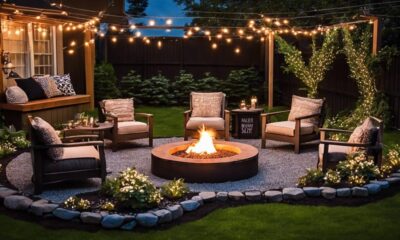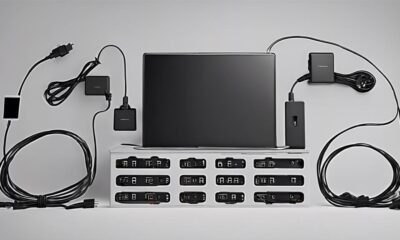Retreat
How to Design a Multi-Purpose Space in Your Retreat Center
How to create a versatile retreat center space that balances comfort and functionality—discover essential tips that will transform your design approach.
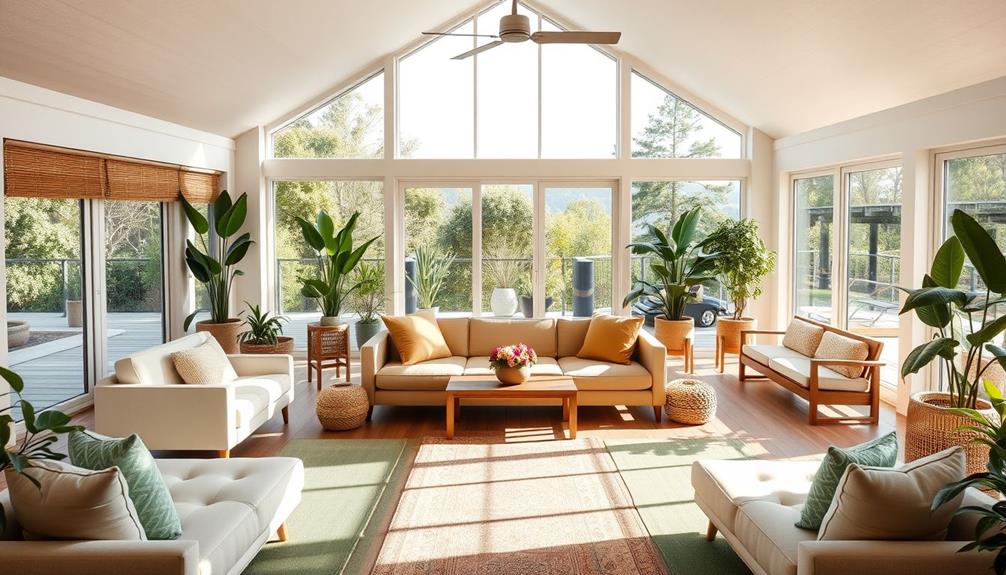
To design a multi-purpose space in your retreat center, focus on flexibility and comfort. Choose modular furniture that can easily adapt to different activities, like foldable tables and stackable chairs. Use calming colors and natural elements to create an inviting atmosphere. Efficient storage solutions will help keep your space organized and clutter-free. Guarantee accessibility with clear pathways and inclusive design features. Plan for various lengths of stay by incorporating adaptable furnishings and communal areas. Finally, consider the unique needs of your retreat and the types of experiences you want to foster. Explore more ideas to elevate your design further.
Key Takeaways
- Utilize Flexible Furniture: Incorporate modular and multi-functional furniture to adapt the space for various activities and group sizes.
- Design for Accessibility: Ensure pathways, entrances, and restrooms are accessible to all participants, promoting inclusivity and ease of navigation.
- Create Defined Activity Zones: Designate specific areas for different activities, allowing for organized transitions and enhancing participant engagement.
- Incorporate Natural Elements: Use natural materials, plants, and calming colors to foster a serene atmosphere and connect participants with nature.
- Plan for Technology Needs: Integrate technology like projectors and sound systems to enhance presentations while maximizing natural light for a refreshing environment.
Location Impact on Design
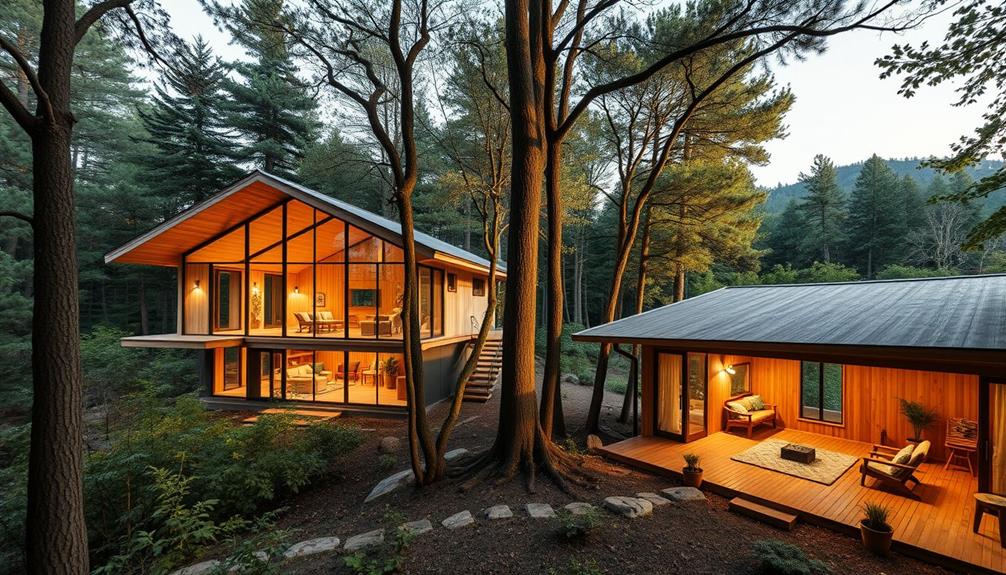
When you choose the location for your retreat center, it directly influences your design choices. The retreat location determines how you'll orient windows to capture stunning views of the surrounding natural features, whether they be mountains, lakes, or forests.
If you're on a slope, consider designing walk-out basements to maximize usable space and offer unique outdoor access, enhancing your guests' retreat experience. Choosing a site near natural features can also provide opportunities for popular activities like hiking and fishing, enriching the overall experience for your guests.
In mountainous areas, steeply pitched roofs are a must to handle heavy snowfall and prevent structural damage. For waterfront properties, you'll need to think about hurricane-proofing and the potential for salt corrosion on materials.
It's essential to assess these factors to guarantee your center stands the test of time. Additionally, maintaining proper setbacks from lakes and rivers is critical to prevent flooding.
Be sure to review county records for high watermark data during your design phase, as this information can guide your decisions and safeguard your investment. Every aspect of your retreat center's design should reflect the unique qualities of its location, ultimately enriching the overall retreat experience for your guests.
Flexible Furniture Solutions
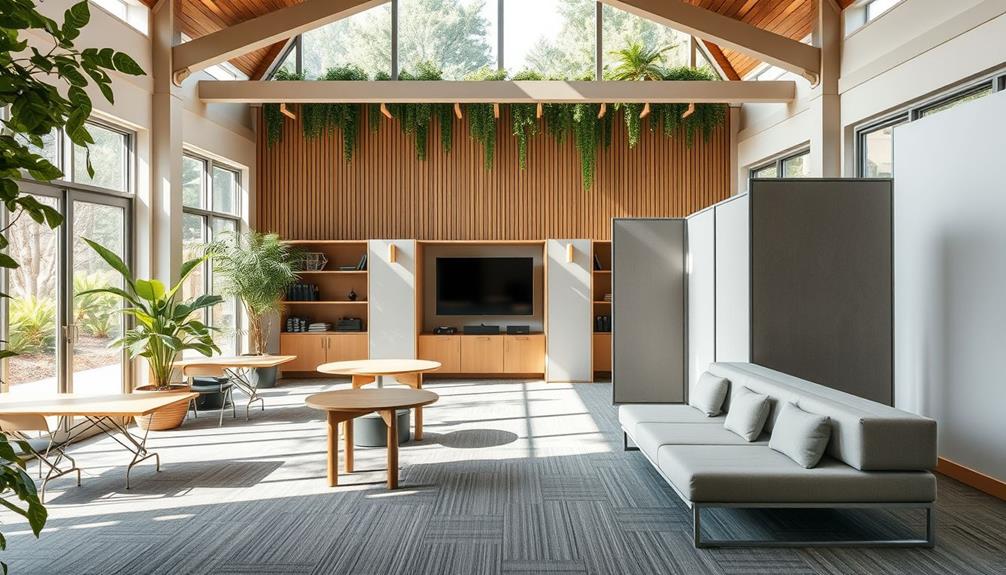
A well-designed retreat center embraces the idea of flexibility, and incorporating versatile furniture solutions can make all the difference. By investing in modular furniture that can be easily reconfigured, you can adapt your space to fit various activities, whether it's yoga classes, workshops, or group meetings.
This approach aligns with the understanding that effective preparation maximizes consultation outcomes and enables you to create a space that meets diverse needs. It maximizes the utility of your area and aligns with your retreat goals.
Here are some flexible furniture solutions to contemplate:
- Modular sofas for lounging or group discussions
- Foldable tables that create an open space when not in use
- Stackable chairs for easy storage and quick setup
- Ottomans with storage to keep supplies organized
- Height-adjustable tables for inclusivity and comfort
These choices not only enhance the versatility of your retreat center but also promote a clutter-free environment conducive to relaxation and focus.
When you prioritize flexibility in your furniture selection, you're not just optimizing your space; you're creating an inviting atmosphere that responds to the diverse needs of your guests.
This thoughtful approach can truly elevate the experience and help achieve your retreat goals.
Color and Natural Elements
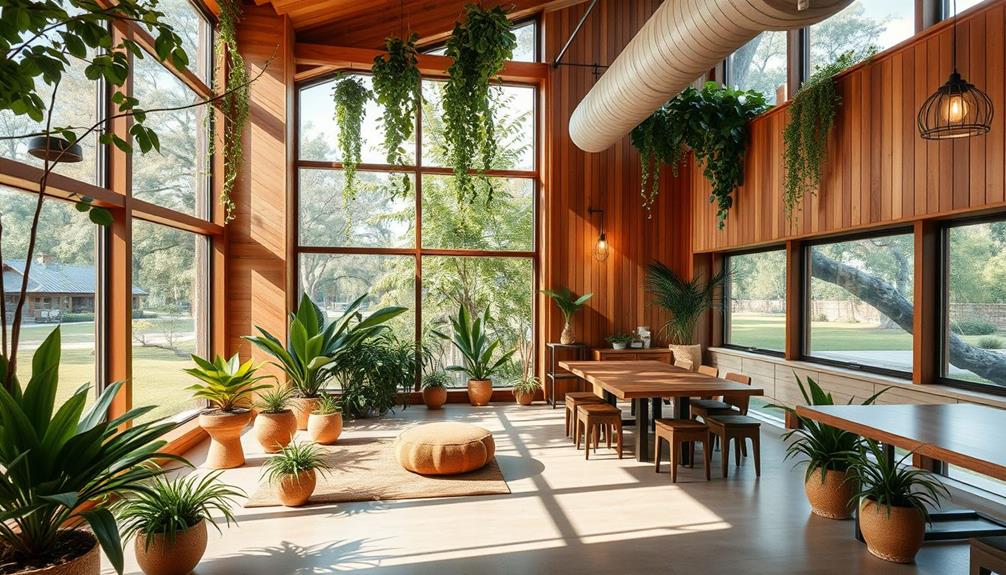
Colors and natural elements play an essential role in creating a serene atmosphere in your multi-purpose retreat space. Choosing calming colors like soft blues and gentle greens can promote relaxation and tranquility, enhancing the experience for participants. Incorporating natural elements, such as houseplants or small water features, improves air quality and fosters a connection with nature.
Here's a quick overview of effective colors and natural elements for your space:
| Colors | Natural Elements |
|---|---|
| Soft blues | Houseplants |
| Gentle greens | Small water features |
| Warm neutrals | Natural wood furnishings |
| Earthy tones | Stone accents |
Using warm lighting, like candles and Himalayan salt lamps, creates a cozy atmosphere that impacts mood positively. Integrating natural materials in your décor, such as wood and stone, evokes grounding and harmony, aligning with your retreat's wellness focus. Finally, personalizing with meaningful items—artwork reflecting nature or inspiring quotes—can deepen participants' emotional connections, supporting their retreat objectives.
Storage and Organization
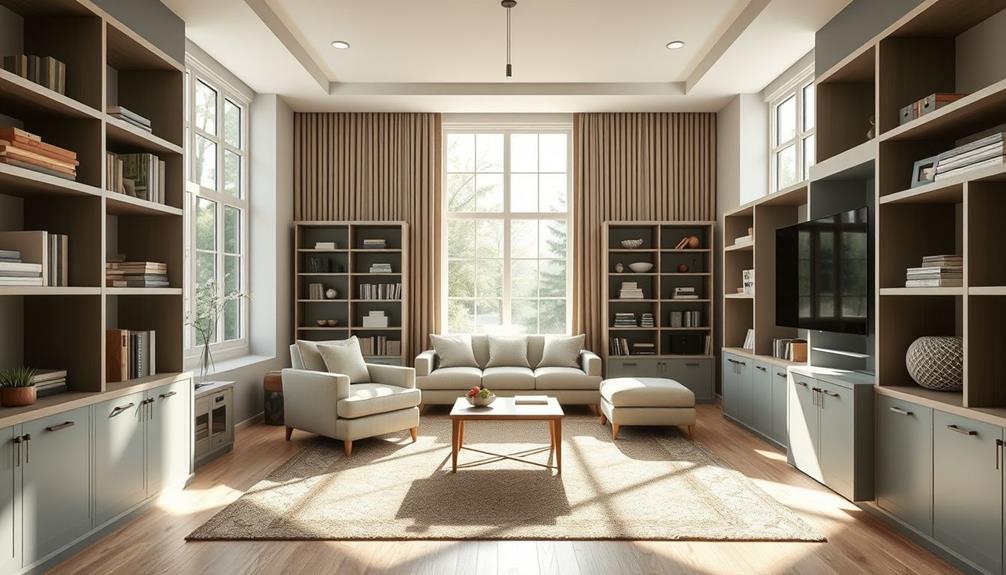
When designing your retreat center, think about how you can make the most of every inch of space.
Efficient storage solutions, like stackable bins and versatile furniture, help keep materials organized and accessible for different activities.
Consider integrating elements from DIY Fire Pit Ideas to create functional outdoor storage that complements the aesthetic of your space.
Efficient Use of Space
Maximizing space in your retreat center is essential for creating an organized and functional environment. An efficient use of space allows you to adapt the area for various engaging activities while keeping it clutter-free.
Start by incorporating built-in storage solutions like benches with hidden compartments or wall-mounted shelves, making the most of your vertical space. Multi-functional furniture, such as ottomans that double as storage bins, can provide flexibility for different uses. Additionally, consider integrating energy-efficient appliances to further streamline operations and promote sustainability within your center, reflecting a commitment to energy-efficient appliances.
To enhance usability, implement a clear labeling system for your storage items, ensuring easy access and efficient retrieval. Designate storage zones for specific activities, like yoga mats or craft supplies, to maintain order and facilitate smooth changes.
Consider these emotional touchpoints for your space:
- A serene environment that promotes relaxation
- Effortless changes between activities
- A sense of community and collaboration
- Easy access to materials for creativity
- A clutter-free sanctuary that inspires tranquility
Versatile Storage Solutions
In a retreat center, having versatile storage solutions is key to maintaining an organized and functional multi-purpose space. By incorporating built-in cabinetry and shelving, you can maximize vertical space while ensuring that equipment and supplies are easily accessible. Multi-functional furniture, like ottomans with hidden storage or foldable tables, allows for smooth changes between activities, catering to varying group sizes and needs.
Here's a quick overview of effective storage options:
| Storage Type | Benefits | Usage Scenario |
|---|---|---|
| Built-in cabinetry | Maximizes space, reduces clutter | General storage for supplies |
| Mobile carts | Flexible and easy to rearrange | For workshops and events |
| Labeled bins | Enhances organization and accessibility | For quick access to materials |
Designating specific areas for items like yoga mats or art supplies streamlines changes and keeps the space inviting. With these versatile storage solutions in place, you'll promote a seamless flow of activities, enhancing the overall experience for participants in your retreat center.
Organizing Activity Materials
Streamlining the organization of activity materials is essential for creating an efficient multi-purpose space in your retreat center. By implementing modular storage solutions like stackable bins and shelving units, you can maximize space and keep everything in order.
Additionally, consider incorporating elements that promote cleanliness, similar to best practices in preventing cross-contact on prep tables, which can enhance the overall organization and safety of your materials. Clear labeling on storage containers guarantees that you can quickly identify and access materials needed for various activities, enhancing the experience for all participants.
Designate specific areas for different types of activities—think arts and crafts, writing, or team-building exercises. This separation fosters a natural flow during your corporate retreat. Incorporating mobile storage carts adds flexibility, allowing you to shift materials between spaces effortlessly.
To maintain this organized environment, regularly conduct inventory checks of your activity materials. This practice guarantees supplies are replenished, preventing disruptions during scheduled activities.
- Create a calm, inviting atmosphere
- Foster creativity and collaboration
- Enhance participant engagement
- Promote smooth shifts between activities
- Boost overall satisfaction and enjoyment
With these strategies, you'll not only streamline your organization but also create a welcoming and efficient multi-purpose space in your retreat center.
Accommodating Various Activities

To create a truly versatile multi-purpose space, you'll want to focus on flexible furniture arrangements that easily adapt to different activities. Movable partitions and stackable chairs are essential for shifting between group activities and individual relaxation areas.
Incorporating a variety of surfaces and layouts is an important thing when accommodating various activities. You can design open floor space for workshops, seating areas for discussions, and quiet corners for meditation.
Here's a simple layout to visualize:
| Activity Type | Layout Style | Key Features |
|---|---|---|
| Workshops | Open floor space | Flexible seating |
| Discussions | Circle or U-shape | Comfortable chairs |
| Meditation | Quiet corner | Soft lighting, cushions |
Utilizing technology, such as projectors and sound systems, also enhances functionality for presentations, team-building exercises, and creative workshops. Don't forget ample storage options for equipment and supplies, ensuring everything stays organized. Finally, consider incorporating natural light and outdoor access, promoting a serene atmosphere for activities like yoga or art workshops while connecting participants to nature.
Creating Comfort and Serenity

Creating a serene atmosphere in your multi-purpose space is essential for fostering relaxation and connection among participants. You can achieve this by selecting calming colors like soft blues and gentle greens that evoke feelings of tranquility. Incorporate natural elements, such as houseplants or small water features, to enhance the connection with nature and further promote serenity.
Additionally, consider using essential oils for relaxation like lavender or eucalyptus to create a soothing olfactory environment, as these scents can help calm the mind and body.
To create an inviting and comfortable environment, consider the following:
- Soft, warm lighting using candles, fairy lights, or Himalayan salt lamps
- Plush chairs and cushions for ultimate relaxation
- Inspiring decor, including meaningful quotes and artwork
- Spaces for quiet reflection or small group discussions
- A calming scent, like lavender or eucalyptus, to soothe the senses
When you prioritize comfort and serenity in your design, participants will feel welcome and encouraged to unwind.
This thoughtful approach not only enhances their experience but also fosters deeper connections among attendees. By creating a nurturing space, you're setting the stage for personal growth, healing, and meaningful interactions.
Planning for Different Lengths of Stay

When planning for different lengths of stay, you'll want to think about how to make the most of your space. High-quality content can help guide your design choices, ensuring that your retreat center meets guest needs effectively.
For short visits, low-maintenance designs that blend living and dining areas work best, while longer stays benefit from defined spaces and extra bathrooms. Flexibility is key, so consider multi-functional furniture and adaptable sleeping arrangements to cater to various guest needs, as user experience enhancements are essential for keeping guests comfortable and engaged.
Short Stay Considerations
Accommodating short stays requires thoughtful design that prioritizes comfort and functionality.
When your retreat involves guests who are visiting only briefly, you want to guarantee they feel welcome and can easily settle in.
Consider incorporating elements that encourage relaxation and recreation, such as hydrotherapy options for stress relief and improved circulation.
- Create an inviting atmosphere that feels like home.
- Design spaces that encourage connection and community.
- Provide efficient storage for recreational gear, keeping areas clutter-free.
- Use convertible furniture to maximize flexibility for varying guest numbers.
- Incorporate cozy nooks for quiet reflection amidst social areas.
Extended Stay Features
Designing a retreat center for extended stays means considering the diverse needs of guests who may be there for days or weeks. To enhance their overall experience, you'll want to incorporate extended stay features that cater to both social interaction and private moments. Larger common areas promote connections among guests while separate sleeping quarters maintain privacy for families or groups.
Establishing a budget for these enhancements is essential for financial health and can help guarantee you allocate funds appropriately for the development of financial terms that support your project.
Multi-functional spaces are essential; they should shift effortlessly from a communal dining area to workshops or relaxation zones. This flexibility maximizes usability throughout the stay. Additionally, adding extra bathrooms can greatly improve convenience for larger groups, reducing wait times and enhancing comfort.
Don't overlook dedicated storage solutions in each accommodation unit. These allow guests to manage their belongings efficiently during longer visits. To create a home-like atmosphere, consider including amenities like laundry facilities and kitchenettes in the units.
These features not only enhance the overall experience but also empower guests to feel more at home, making their extended stay enjoyable and stress-free. By thoughtfully planning these aspects, you'll create a welcoming environment that meets the varied needs of your guests.
Tailoring Spaces for Specific Retreats

Creating a versatile environment tailored for specific retreats can greatly enhance participants' experiences. When you design flexible spaces, you're not just accommodating different activities; you're creating an atmosphere that resonates with their needs.
Whether it's a yoga class or a spiritual retreat, your center should reflect the purpose of each gathering. Emphasizing user-centric design can lead to innovative solutions that meet diverse needs, aligning perfectly with design thinking principles.
Here are some essential elements to contemplate:
- Movable partitions for dynamic workshop setups
- Natural light to uplift spirits and foster creativity
- Comfortable, adaptable furniture for all group sizes
- Effective acoustics to support quiet reflections or lively discussions
- Essential amenities like AV equipment for seamless presentations
Ensuring Accessibility and Flow

How can you guarantee that every participant feels welcome and included in your retreat center? Start by prioritizing accessibility throughout your design. Confirm all entrances and pathways are at least 36 inches wide, allowing easy movement for wheelchairs and walkers.
Incorporate ramps with a gentle slope (1:12 ratio) to provide access to elevated areas, making your space more inclusive for those with mobility challenges.
Next, pay attention to restrooms. Design them with accessible features like grab bars, lower sinks, and wider stalls (at least 60 inches) to confirm comfort and safety for everyone.
Clear signage is essential; use high contrast and large fonts to guide participants effectively, considering those with visual impairments.
Frequently Asked Questions
How Do You Make a Retreat Space?
To make a retreat space, start by choosing a quiet location. Incorporate flexible furnishings and calming decor. Confirm essential amenities are available while creating distinct areas for various activities, promoting relaxation and connection among participants.
How Do You Structure a Work Retreat?
Structuring a work retreat's like orchestrating a symphony; you'll enhance teamwork, create a detailed agenda blending work sessions and relaxation, and guarantee flexibility for spontaneous ideas, keeping everyone engaged and aligned with your goals.
Is Owning a Retreat Center Profitable?
Yes, owning a retreat center can be profitable. With diverse clientele and effective marketing, you can boost occupancy rates. Proper management of costs and services will enhance your financial sustainability and community impact.
How to Plan a Creative Retreat?
Planning a creative retreat isn't just about slapping some paint on walls and calling it art. You'll need to know your audience, mix structured activities with free time, and create a supportive community.
Conclusion
So, you're ready to design that multi-purpose space, huh? Just remember, if it's not versatile enough to host yoga, a corporate meeting, and a spontaneous interpretive dance session all at once, you might as well toss it out the window! Embrace the chaos, throw in some bean bags, and let the colors clash like a toddler's art project. After all, who needs serenity when you can have a vibrant circus of activities? Happy designing!
- About the Author
- Latest Posts
Introducing Ron, the home decor aficionado at ByRetreat, whose passion for creating beautiful and inviting spaces is at the heart of his work. With his deep knowledge of home decor and his innate sense of style, Ron brings a wealth of expertise and a keen eye for detail to the ByRetreat team.
Ron’s love for home decor goes beyond aesthetics; he understands that our surroundings play a significant role in our overall well-being and productivity. With this in mind, Ron is dedicated to transforming remote workspaces into havens of comfort, functionality, and beauty.
Retreat
Creating an Indoor Garden for Year-Round Greenery
Transform your living space with an indoor garden, where vibrant plants thrive year-round—discover the essential tips to cultivate your green oasis.

Creating an indoor garden means you can enjoy fresh greens and vibrant plants year-round, no matter the season. Start by choosing the right containers with drainage holes to prevent root rot. Make sure your plants get at least 12 hours of light daily, using LED grow lights if necessary. Monitor temperature closely, as different plants thrive at varying degrees. Select fast-growing options like kale or microgreens for quick harvests. With attention to soil quality and moisture control, you'll cultivate a thriving indoor oasis. There's a lot more to explore on maintaining and enhancing your indoor garden!
Key Takeaways
- Select a variety of fast-growing plants like leafy greens and herbs for continuous harvest throughout the year.
- Ensure adequate lighting by using LED grow lights for at least 12 hours daily, especially during winter months.
- Maintain optimal temperature and humidity levels tailored to the specific needs of your chosen plants.
- Use high-quality, well-draining potting soil and containers with drainage holes to prevent root rot.
- Regularly monitor moisture levels and practice proper watering techniques to keep plants healthy and thriving.
Benefits of Indoor Gardening

Indoor gardening offers numerous benefits that can transform your living space and enhance your lifestyle. By growing food indoors, you gain access to fresh vegetables and nutrient-rich greens year-round, even in winter when outdoor gardening isn't an option.
The simplicity of container gardening means you don't need a large outdoor space or extensive equipment; all you need are a few pots, soil, and seeds to get started. Additionally, you can explore unique and wicked planters that not only serve as functional gardening solutions but also enhance your home decor.
You'll find that indoor gardens produce high yields quickly, with some crops ready for harvest in as little as 7 to 10 days from seed germination. This rapid growth not only satisfies your cravings for fresh produce but also encourages a healthier diet.
Plus, growing food indoors considerably reduces your carbon footprint by minimizing transportation needs, which supports local eating habits and fosters self-sufficiency.
Indoor gardening also invites experimentation with diverse varieties of greens and growing techniques, allowing you to expand your culinary repertoire. Embracing this practice can lead to a more sustainable lifestyle while filling your home with greenery that brightens your space and mood.
Immerse yourself in the world of indoor gardening and enjoy these incredible benefits!
Essential Light Requirements
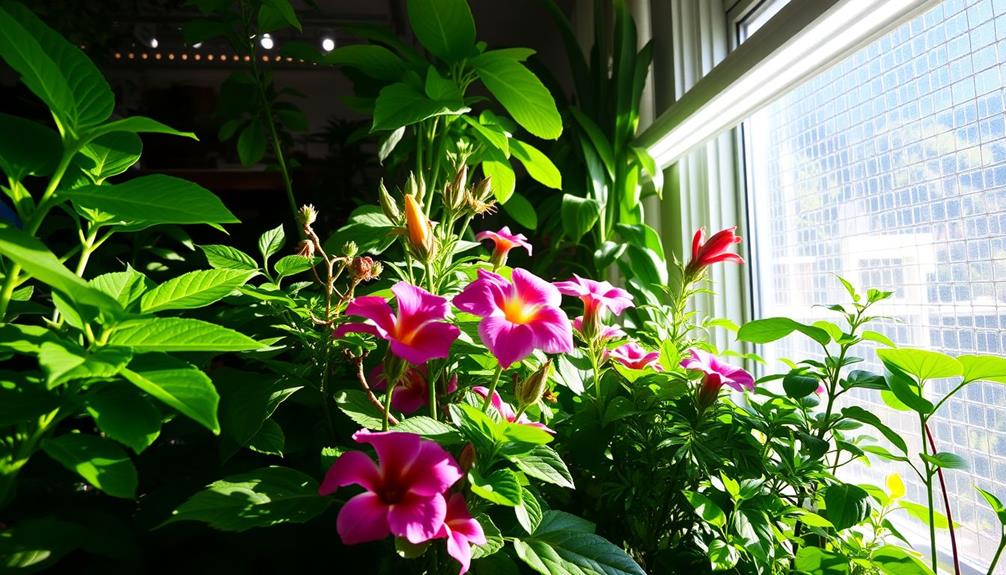
To guarantee your indoor garden thrives, understanding essential light requirements is crucial. Most plants grown indoors need a minimum of 12 hours of light daily for ideal growth. Some varieties, especially fruit-bearing ones like tomatoes, may require up to 20 hours.
During winter months when natural light is scarce, you may need to supplement with LED grow lights. These lights should be positioned close to your plants, ensuring they receive adequate light without becoming leggy or yellowing, which signals insufficient light. Additionally, considering the significance of quality in your gardening setup can enhance your indoor gardening experience, much like how quality coffee brewing methods affect flavor and enjoyment different brewing methods.
For effective growth, use bulbs rated between 5,000-6,500 Kelvin and around 2,500 lumens. Additionally, don't overlook the significance of air movement. Incorporating fans can simulate outdoor conditions, providing gentle air circulation while avoiding harmful drafts. This helps maintain your plants' health and encourages robust growth.
To maximize light exposure, consider using reflective materials like Mylar in your grow space. This will enhance light distribution and prevent moisture damage.
Choosing the Right Containers
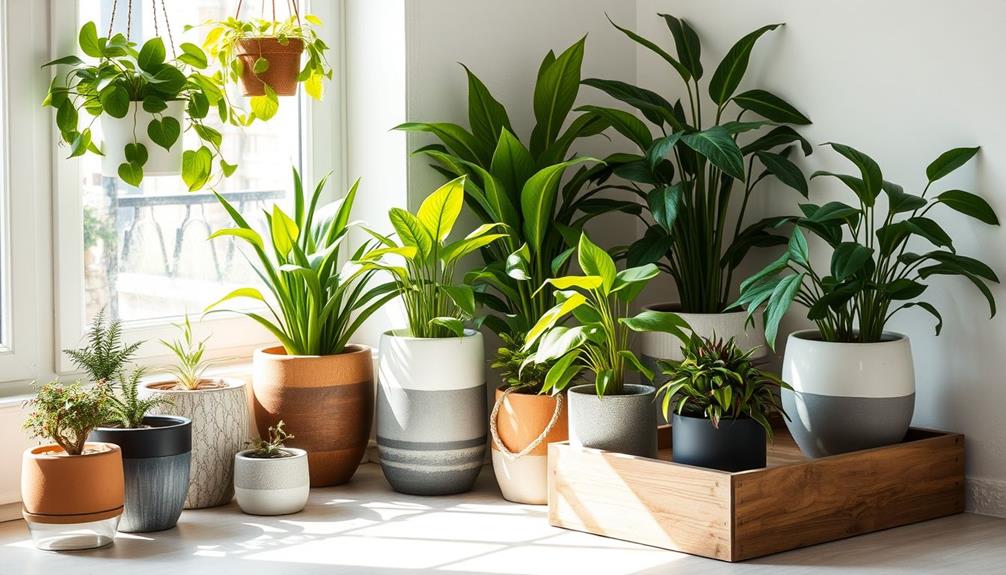
Selecting the right containers is vital for your indoor garden's success. The containers you choose directly affect your plants' health, growth, and overall productivity.
For instance, using natural materials can enhance the overall environment for your plants, similar to how healthy dog snacks contribute to your pets' wellness.
Here are four key considerations:
- Drainage Holes: Always opt for containers with drainage holes to prevent waterlogging, which can lead to root rot and other diseases.
- Size Matters: Larger pots are important for adult plants, as they enhance yields and promote healthy root growth. Smaller containers can limit your plants' health and productivity.
- Material Choice: Consider eco-friendly options like biodegradable EcoForms pots or terra cotta, which offer better air circulation and moisture regulation than plastic.
- Depth: Confirm your containers are at least four inches deep for leafy greens, while larger plants like tomatoes will need even more space for their substantial root systems.
Soil Quality and Drainage

For thriving plants in your indoor garden, soil quality and drainage are fundamental factors that shouldn't be overlooked. Quality potting soil helps regulate moisture, retaining just enough while allowing for proper drainage. This balance is vital in preventing root rot, which can devastate your plants.
Incorporating essential oils, such as peppermint oil, can also promote a healthier indoor environment by reducing stress on plants and enhancing air quality.
To enhance drainage, consider creating a DIY system using plastic dishpans with holes. This setup elevates your containers and lets excess water drain away from the roots, promoting healthier growth.
Remember, overwatering can lead to soggy soil, so always choose potting soil that drains well and containers with sufficient drainage holes.
It's also wise to flush your soil regularly with water to remove mineral buildup. This simple step maintains soil quality and guarantees a healthy environment for your plants' roots.
When it comes to reusing potting soil, be cautious; exhausted soil should be composted or sterilized to eliminate any pests or harmful bacteria.
Temperature Control for Growth

To grow healthy plants indoors, you need to keep an eye on temperature control.
Ideal ranges vary by plant type, like lettuce thriving at 65-70°F and peppers preferring 85°F during germination.
Incorporating elements like DIY Fire Pit Ideas can enhance your overall indoor gardening experience by creating a cozy atmosphere.
Using temperature monitoring tools and ensuring proper airflow can make a big difference in your indoor garden's success.
Optimal Temperature Range
Creating an ideal environment for your indoor garden hinges on maintaining the right temperature range for your plants. The best temperature range is essential for growing vegetables and ensuring their health. Here are four key points to take into account:
- Lettuce thrives best between 65-70°F, with a minimum of 50°F for germination.
- Peppers germinate at 85°F but can adapt to a wider range after sprouting. Additionally, incorporating natural remedies alongside conventional methods can enhance your plant care routine.
- Temperature fluctuations can stress your plants, leading to growth issues.
- Regular monitoring of indoor temperatures is essential, as they can vary greatly from outdoor climates.
To create a successful indoor garden, make sure you maintain the best temperature range for the specific plants to grow indoors.
Use fans to promote air movement, which helps strengthen your plants but avoid drafts that could harm them.
By keeping a close eye on temperature conditions, you'll foster a healthy environment for your indoor gardens, allowing your plants to thrive year-round.
Light and Airflow
Maintaining the right temperature is important, but light and airflow play a significant role in your indoor garden's success too. Your plants need at least 12 hours of light daily for ideal growth, so consider using grow lights, especially during winter months when natural light is scarce.
Incorporating structured creativity exercises can also enhance your gardening approach, allowing you to think outside the box when designing your indoor space, thereby creating a more engaging and productive environment design thinking leadership. Position these lights close to your plants to enhance light absorption and prevent issues like yellowing or leggy growth.
When it comes to airflow, creating a gentle breeze is essential. Use fans or occasionally open windows to mimic outdoor conditions, which helps strengthen your indoor plants. Just be cautious of drafts that could disrupt their growth.
For leafy greens like lettuce, aim for temperatures between 65-70°F, while ensuring a minimum of 50°F for germination. Keep in mind that different plants have varying temperature preferences; for instance, peppers thrive best at around 85°F but can tolerate a wider range once established.
Temperature Monitoring Tools
Effective temperature monitoring tools are vital for any indoor gardener looking to create ideal growing conditions.
These tools can help guarantee that your plants receive the proper care they need to thrive, especially when managing elements like humidity and airflow. Without them, your plants may struggle to thrive.
Here are four key tools to take into account:
- Digital Thermometers: Monitor temperature with precision to guarantee it remains within the ideal range for your plants.
- Hygrometers: Track humidity levels, which is essential for preventing mold and guaranteeing your plants get the moisture they need.
- Programmable Thermostats: Automatically adjust heating or cooling systems to maintain consistent temperature levels.
- Fans: Facilitate air circulation, helping to moderate temperatures and distribute humidity evenly throughout your garden.
Incorporating yoga for back pain can also enhance your indoor gardening experience by promoting relaxation and reducing stress while you nurture your plants.
Managing Water and Moisture
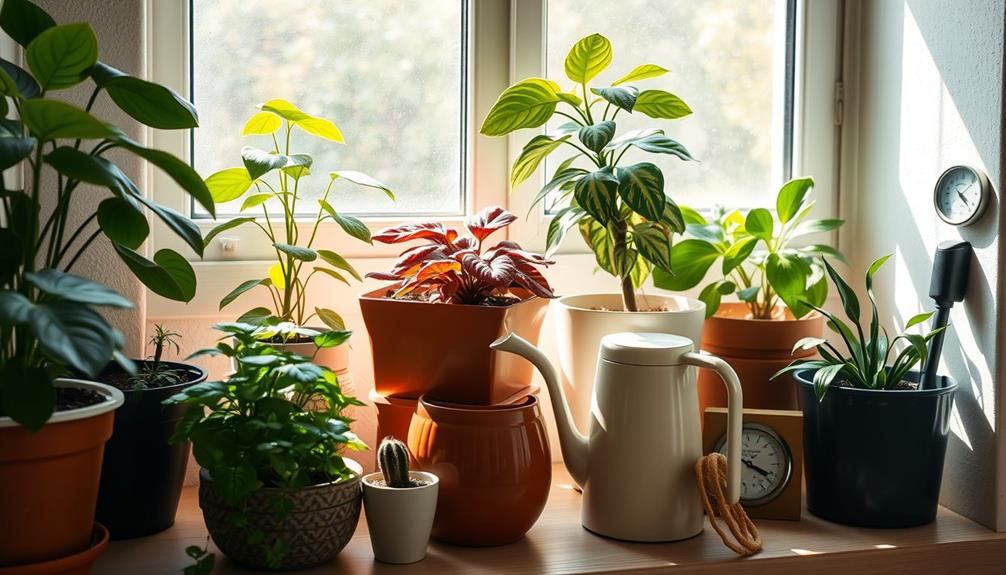
When managing water and moisture for your indoor garden, keeping an eye on your watering frequency is essential.
It's also beneficial to take into account using energy-efficient appliances to help automate your watering system and maintain ideal moisture levels.
Make sure your pots have drainage holes to prevent water from pooling, which can lead to root rot.
Watering Frequency Guidelines
Keeping your indoor garden thriving hinges on understanding the watering frequency your plants need. Indoor vegetables tend to dry out faster due to increased light and heat, so it's important to keep an eye on their moisture levels.
Emotional and psychological growth can also be influenced by the nurturing environment you create with your plants. Here are some guidelines to help you manage your watering frequency effectively:
- Check Soil Moisture: Regularly monitor soil moisture by sticking your finger in the top inch. If it feels dry, it's time to water.
- Maintain Evenly Moist Soil: Aim for consistently moist soil without making it soggy. This balance supports healthy plant growth.
- Adjust for Light Exposure: If your plants are under grow lights, they may need more frequent watering due to accelerated drying rates.
- Watch for Excess Water: Allow excess water to drain into saucers but avoid letting it sit, as standing water can cause root rot.
Drainage System Importance
A well-designed drainage system is essential for maintaining healthy plants in your indoor garden. Without it, soggy potting soil can suffocate roots and lead to root rot, a common problem that can quickly kill your plants. To prevent this, use containers with drainage holes, allowing excess water to escape and keeping moisture levels just right.
You might consider DIY drainage solutions, like repurposing plastic dishpans with holes, to effectively manage excess water. Regularly monitoring moisture levels is critical; it helps you guarantee that your plants receive the right amount of water without becoming waterlogged. Over time, this practice enhances plant health and productivity.
Additionally, investing in quality potting soil designed for good drainage properties is essential. This supports moisture regulation and contributes to the overall vitality of your indoor garden.
Plant Selection for Indoors

Selecting the right plants for your indoor garden can transform your space into a vibrant oasis. With careful plant selection for indoors, you'll enjoy fresh greens and a variety of vegetable plants year-round.
Here are some excellent choices to evaluate for your indoor garden:
- Leafy Greens: Kale, arugula, and spinach thrive indoors and can be harvested in just 7 to 14 days.
- Microgreens: Sunflower and pea shoots grow quickly, maturing in only 2 to 3 weeks while packing a nutritional punch.
- Tomatoes: Smaller varieties can flourish indoors but need at least 14 to 20 hours of light and several months to bear fruit.
- Herbs: Basil, chives, and green onions are perfect for growing herbs indoors, with green onions even regrowing from kitchen scraps in just weeks.
Propagation Techniques

When you want to expand your indoor garden, cloning mature plants and saving seeds are great propagation techniques.
By taking cuttings from your healthiest plants, like Sun Sugar tomatoes, you can guarantee a steady supply of your favorites.
Additionally, saving seeds from fruits like peppers and cucumbers can help you grow new generations while keeping your space vibrant all year round.
Cloning Mature Plants
Cloning mature plants is a rewarding way to expand your indoor garden while preserving the unique qualities of your favorites, like Sun Sugar tomatoes.
By taking cuttings from healthy, vigorous plants, you can propagate new plants that share the same desirable traits.
Here are four essential steps to guarantee successful cloning:
- Choose the Right Cuttings: Select cuttings that are 4-6 inches long and ascertain at least one node will be submerged in the rooting medium.
- Create the Ideal Environment: Maintain proper humidity and a clean environment to encourage rooting and prevent disease.
- Use Rooting Hormone: Applying rooting hormone on the cut ends can stimulate root development and greatly improve your success rates.
- Provide Ideal Conditions: Regularly mist the cuttings and place them in a warm, bright area, avoiding direct sunlight to promote vigorous growth.
Seed Saving Methods
Seed saving can be one of the most rewarding aspects of indoor gardening, allowing you to preserve and cultivate your favorite heirloom varieties. By saving seeds from heirloom tomatoes, peppers, and cucumbers, you guarantee that your plants produce true offspring, retaining the quality you love.
When it comes to bolted greens, consider transplanting them outdoors for seed harvesting, freeing up valuable indoor space.
Proper drying and storage are essential for successful seed saving. After collecting seeds, make certain to dry them thoroughly before storing them in a cool, dry place to maintain their viability for future planting.
Additionally, if you're looking to expand your garden without starting from scratch, cloning can be an effective propagation method. Taking cuttings from mature plants, like Sun Sugar tomatoes, allows you to enjoy continuous growth of your preferred varieties.
Before planting your saved seeds, don't forget the importance of sterilizing potting soil. This step eliminates pests and harmful bacteria, guaranteeing a healthy environment for any propagated plants.
Harvesting Tips and Techniques

Harvesting your indoor greens at the right time is essential for maximizing their flavor and texture. To guarantee you get the best out of your indoor garden, follow these simple tips:
- Height Matters: Harvest greens when they reach a height of 6 to 10 inches. Use scissors or a sharp knife to cut them without damaging the plant's base.
- Clean Your Greens: Rinse harvested greens in fresh water to remove any floating seed hulls. This step helps maintain their freshness.
- Cut for Flavor: When preparing your greens, cut them into small pieces with the stem end at about 1/4 inch and the leaf end longer. This enhances texture and flavor, especially in salads.
- Versatile Varieties: Buckwheat lettuce, radish, and sunflower greens offer versatility. You can use them whole or chopped in various dishes.
Regular harvesting encourages continuous growth, so aim for an average of 14 ounces daily from five small aluminum bread pans.
Overcoming Indoor Gardening Challenges

Indoor gardeners often face unique challenges that can hinder plant growth and productivity. One major hurdle is the need for constant human intervention, as indoor gardening lacks natural conditions necessary for healthy plants.
You may find that space limitations restrict larger crops, so focusing on compact vegetables like leafy greens and herbs can help maximize your garden's output.
Another challenge is the absence of natural insect predators, which can lead to pest infestations. Stay vigilant and educate yourself on common pests and their management strategies.
Automated systems for watering and lighting can ease some of the manual labor involved, but they're not always practical for every setup.
It's also essential to remember that indoor gardening can supplement your outdoor efforts. During the off-season, when you can't grow plants outside, your indoor garden can provide fresh produce and support your nutritional needs.
Frequently Asked Questions
What Vegetables Can Be Grown Indoors All Year-Round?
You can grow leafy greens like lettuce and spinach, compact vegetables such as radishes, and herbs like basil or parsley indoors year-round. These options thrive in small spaces and provide fresh produce quickly.
How Do You Make a Year-Round Herb Garden Indoors?
You can successfully create a year-round herb garden indoors by choosing the right herbs, ensuring proper lighting and moisture, and maintaining humidity. Regular fertilization is key to keeping your herbs healthy and thriving.
Can You Grow Plants Year-Round Indoors?
Yes, you can grow plants year-round indoors! With proper lighting, temperature control, and regular care, you'll cultivate thriving greenery. Just make sure you monitor moisture, pests, and provide enough space for healthy root growth.
Can You Grow a Garden Year-Round in a Greenhouse?
Imagine a cozy hobbit hole filled with vibrant plants; you can absolutely grow a garden year-round in a greenhouse! With proper heating, lighting, and humidity, your plants thrive regardless of the weather outside.
Conclusion
So, you've decided to transform your home into a lush jungle? Bravo! Just remember, while your leafy friends thrive on your attention, they won't appreciate your off-key singing or your penchant for forgetting to water them. But hey, what's a little chaos in the pursuit of indoor greenery? If you can keep a houseplant alive, you can probably run a small country. So roll up your sleeves, avoid the drama, and let your indoor garden flourish—hopefully without any casualties!
- About the Author
- Latest Posts
Introducing Ron, the home decor aficionado at ByRetreat, whose passion for creating beautiful and inviting spaces is at the heart of his work. With his deep knowledge of home decor and his innate sense of style, Ron brings a wealth of expertise and a keen eye for detail to the ByRetreat team.
Ron’s love for home decor goes beyond aesthetics; he understands that our surroundings play a significant role in our overall well-being and productivity. With this in mind, Ron is dedicated to transforming remote workspaces into havens of comfort, functionality, and beauty.
Retreat
DIY Spa Treatments You Can Offer at Your Retreat Center
You can transform your retreat center with DIY spa treatments that promote relaxation and connection—discover the secrets to creating a rejuvenating experience for your guests!
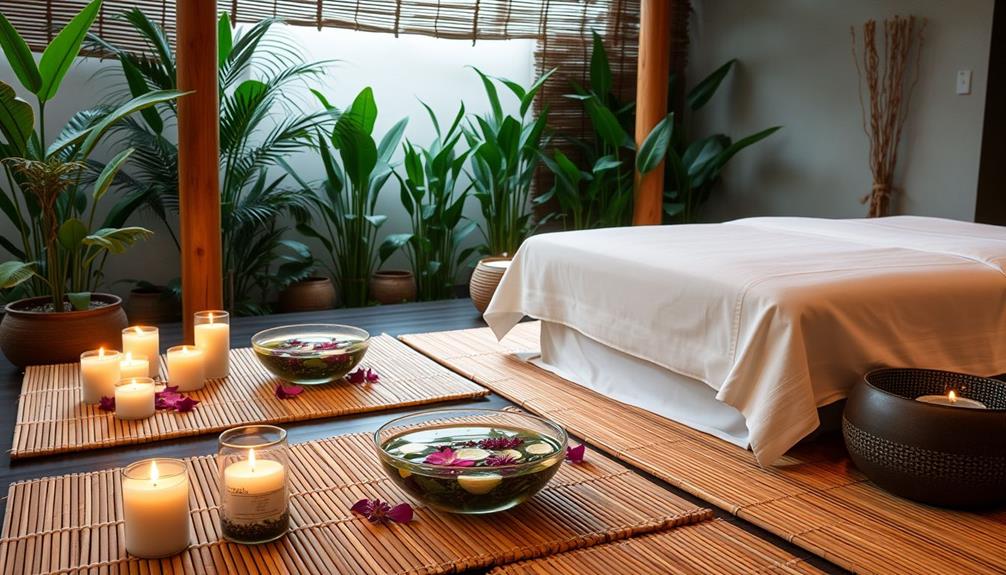
You can elevate your retreat center by offering DIY spa treatments that encourage relaxation and connection. Start with nourishing face masks using ingredients like honey and yogurt. Incorporate exfoliating body scrubs with coconut oil and sea salt to rejuvenate skin. Don't forget guided self-massage techniques that foster mindfulness and relieve tension. Create a calming atmosphere with ambient lighting and soothing soundscapes, enhancing the overall experience. Tailor treatments based on skin types to meet your guests' needs. If you'd like to discover more ways to enhance your spa offerings, there are additional insights that can help you flourish.
Key Takeaways
- Offer DIY body scrubs using natural ingredients like sugar, coconut oil, and essential oils for exfoliation and hydration.
- Provide simple facial mask recipes using honey, yogurt, and fresh herbs to nourish and soothe skin.
- Incorporate guided self-massage techniques to promote relaxation and improve body awareness among participants.
- Create a calming atmosphere with ambient lighting, nature sounds, and natural decor to enhance the spa experience.
- Customize treatments for various skin types, including hydrating options for dry skin and soothing masks for sensitive skin.
Benefits of DIY Spa Treatments

When you indulge in DIY spa treatments, you tap into a range of benefits that enhance both your physical and mental well-being. Engaging in activities like facials and massages can notably lower your cortisol levels, reducing stress by up to 30%. This reduction not only helps you feel more relaxed but also plays an essential role in your overall mental health.
Incorporating natural ingredients such as essential oils can further amplify these benefits, as certain oils like lavender and eucalyptus offer calming and restorative properties that enhance relaxation and promote emotional balance, providing essential oils for relaxation.
DIY spa treatments promote mindfulness, allowing you to focus on the sensory experiences that come with each treatment. This practice encourages you to be present, improving your mental clarity and emotional balance.
Plus, using natural ingredients like honey and avocado creates customizable skincare solutions that nourish your skin without harsh chemicals, making your wellness routine even more satisfying.
Incorporating these treatments into a DIY Wellness Retreat fosters a sense of community and connection among participants. Sharing experiences and techniques enhances social wellness, making everyone feel more engaged and supported.
Ultimately, embracing DIY spa treatments can lead to increased satisfaction in your wellness journey, promoting a holistic approach to reducing stress and improving mental health.
Essential Ingredients for Treatments

Creating your own spa experience at home hinges on the right ingredients. Essential oils like lavender, eucalyptus, and tea tree oil are crucial for their therapeutic properties, which may also help with gastrointestinal issues when used in certain treatments.
You can use these oils in various treatments to promote relaxation and enhance skin health. Coconut oil, for instance, is a fantastic choice for massages, providing deep moisture and allowing for smooth application on the skin.
For a soothing bath, consider using sea salt or Epsom salt. Both help reduce muscle soreness and relax your body through magnesium absorption. Pair these salts with essential oils for an elevated experience.
Don't overlook natural ingredients like honey and yogurt; they make excellent bases for hydrating face masks, delivering nourishment thanks to their humectant properties.
Fresh herbs such as mint and rosemary can also enhance your treatments, offering invigorating scents and natural antibacterial benefits when infused in oils or used in scrubs.
Creating a Relaxing Atmosphere

To create a truly relaxing atmosphere for your DIY spa treatments, focus on ambient lighting techniques, calming soundscapes, and natural decor elements.
Soft lighting, like candles or dimmed bulbs, sets a soothing tone, while nature sounds or gentle music can enhance your relaxation.
Incorporating essential oils, such as lavender or chamomile, can also elevate the experience by providing therapeutic benefits and essential oils for relaxation to promote a sense of calm.
Incorporating plants or other natural touches adds to the serene environment, helping you unwind completely.
Ambient Lighting Techniques
A well-designed lighting scheme can transform your spa space into a tranquil retreat. To enhance relaxation, focus on incorporating ambient lighting that soothes the senses.
Natural light is essential, as it boosts mood and energy levels; consider large windows or skylights to invite daylight in. Additionally, a calming environment can be further supported by the use of natural remedies alongside conventional medications, which can promote overall wellness during spa treatments.
Avoid harsh fluorescent bulbs, opting instead for softer, warmer lighting that calms the mind and reduces stress.
Adjustable lighting options, like dimmable lamps and candles, allow you to customize the atmosphere for various activities, ensuring every guest feels comfortable. Light therapy lamps can also be a game-changer, especially during winter months. They simulate natural sunlight, helping alleviate symptoms of Seasonal Affective Disorder (SAD) and improving overall well-being.
Layering your ambient lighting with wall sconces or string lights creates a cozy environment, encouraging guests to unwind and disconnect from daily stressors.
This thoughtful approach to lighting not only elevates the aesthetic of your wellness resort but greatly enhances the relaxation experience. By paying attention to these ambient lighting techniques, you'll create a serene atmosphere, making your retreat center a haven for rejuvenation.
Calming Soundscapes
There's something magical about calming soundscapes that can instantly transform your spa experience. By incorporating sounds of nature or gentle instrumental music, you can greatly reduce stress levels and promote relaxation. Research shows that these soothing sounds lower heart rate and blood pressure, creating a tranquil environment for your guests.
Integrating calming soundscapes into activities like meditation or yoga can deepen the experience, helping participants reach a meditative state more easily. Sound therapy is linked to improved mood and emotional well-being, making it an essential component of any wellness program.
To optimize the sound experience, consider using high-quality sound systems or portable speakers. Here's a quick reference to help you choose the right soundscapes:
| Sound Type | Benefits |
|---|---|
| Nature Sounds | Reduces stress, promotes relaxation |
| Gentle Instrumental | Enhances focus, aids meditation |
| Ambient Ocean Waves | Calming, lowers anxiety |
| Soft Chimes | Uplifts mood, improves emotional well-being |
Natural Decor Elements
Creating a relaxing atmosphere in your spa can be achieved by thoughtfully incorporating natural decor elements.
Start by adding indoor plants; they not only enhance aesthetic appeal but also improve air quality and foster tranquility. Research shows that greenery reduces stress and elevates mood, promoting overall health and well-being.
Additionally, incorporating elements of music therapy integration can further enhance the calming environment, as soothing sounds contribute to relaxation and emotional well-being.
Next, consider using natural elements like stones, driftwood, or bamboo to create a calming ambiance. These materials connect your guests to nature, which can lower blood pressure and cortisol levels, enhancing relaxation.
Choose soft, calming colors for your decor—think greens, blues, and earth tones. These hues evoke comfort and serenity, contributing to a peaceful environment.
Maximize natural light with large windows or skylights. Sunlight boosts mood and energy levels, promoting serotonin production and better sleep patterns.
Simple Facial Mask Recipes

Looking to pamper your skin without the hefty spa price tag? Try these simple facial mask recipes that'll make you feel like you're enjoying a spa day right at home.
These natural ingredients not only nourish your skin but also complement your relaxing bath and healthy meals, much like creating an inviting outdoor space with DIY Fire Pit Ideas for a serene atmosphere.
First up, the Honey and Oatmeal Mask. Mix equal parts of honey and finely ground oatmeal for a hydrating treat that soothes and gently exfoliates.
Next, blend half a ripe avocado with two tablespoons of plain yogurt for a creamy mask rich in healthy fats that promote moisture and skin elasticity.
If you're looking for something revitalizing, mash one ripe banana with a tablespoon of coconut oil. This combo hydrates dry skin and reduces the appearance of fine lines.
For a rejuvenating option, combine cooled green tea with two tablespoons of aloe vera gel to calm irritation and redness.
Lastly, puree half a cucumber and mix it with yogurt for a cooling mask perfect for sunburned or sensitive skin.
These easy recipes will elevate your skincare routine and help you feel rejuvenated!
DIY Body Scrub Ideas

Transform your skin with these easy DIY body scrub ideas that exfoliate and nourish. Creating a DIY body scrub can be a relaxing way to enhance your wellness routine, especially as you explore various brewing methods for coffee that can also provide a delightful aroma in your space.
Start by mixing 1 cup of sugar or salt with 1/2 cup of coconut oil and a few drops of soothing essential oils like lavender or eucalyptus. This blend offers a calming experience while effectively sloughing off dead skin.
For an invigorating option, combine coffee grounds with coconut oil and a pinch of cinnamon. This scrub not only improves circulation but can also help reduce the appearance of cellulite.
If you're looking for hydration, mix 1 cup of brown sugar with 1/2 cup of honey and 1/4 cup of olive oil. This combination moisturizes and provides natural antibacterial benefits.
For sensitive skin, try a gentle scrub made from 1/2 cup of ground oats and 1/2 cup of plain yogurt.
Finally, whip up a citrus-infused scrub by mixing 1 cup of sea salt with the zest of one lemon or orange and 1/2 cup of olive oil for a reviving scent that brightens your skin.
Enjoy these delightful DIY body scrubs at your retreat center!
Guided Self-Massage Techniques

Ready to unwind? Guided self-massage techniques can be simple yet effective ways to reduce muscle tension and enhance relaxation.
Incorporating practices like deep breathing techniques can further amplify your relaxation experience, allowing you to release built-up stress more effectively.
For more insights on relaxation methods, check out yoga for back pain.
Let's explore some easy techniques, essential tools, and the benefits of incorporating self-massage into your routine.
Simple Techniques Overview
Incorporating guided self-massage techniques into your routine can greatly enhance your relaxation and well-being. These simple methods are perfect for reducing muscle tension and promoting both mental and physical relaxation, making them a valuable addition to any retreat experience.
Additionally, integrating mindfulness practices can further amplify the benefits of these techniques, helping participants to stay present and engaged during their sessions.
Start with the "palm rolling" method for your hands and forearms. This technique stimulates circulation and helps relieve stress, allowing you to feel more at ease.
For neck and shoulder tension, try gentle squeezes to alleviate headaches and improve posture—especially beneficial if you've been sitting for long periods.
To amplify the relaxation effects, consider using essential oils. Lavender is ideal for calming, while peppermint can provide an energizing boost during your self-massage sessions.
Practicing these guided self-massage techniques regularly not only aids in relaxation but also fosters improved body awareness and mindfulness.
This deeper connection between your mind and body will enhance your overall retreat experience, making it even more fulfilling.
Essential Tools Required
To get the most out of your guided self-massage sessions, you'll need a few essential tools that can enhance your experience and effectiveness. First, consider using massage balls, foam rollers, and handheld massagers. These tools help release muscle tension, promoting relaxation and supporting your physical health.
Incorporating a proper diet can also contribute to overall wellness, as highlighted in ultimate hamster care for pets, which emphasizes the importance of nutrition for health maintenance.
Incorporating high-quality oils or lotions during your self-massage can improve glide and hydration, making the process smoother. Opt for essential oils like lavender or eucalyptus to amplify relaxation benefits further.
You can also implement various guided self-massage techniques, such as the "palm kneading" method for the back and "thumb walking" for the feet. These techniques can notably reduce stress and muscle stiffness, making your sessions more effective.
To keep your practice focused, utilize a timer or calming music to set intervals, ensuring you dedicate sufficient time to each area.
Finally, providing instructional posters or handouts detailing step-by-step self-massage techniques can empower attendees to practice independently, nurturing ongoing wellness habits beyond the retreat.
With these essential tools, you'll create a transformative self-massage experience that enhances relaxation and supports overall physical health.
Benefits of Self-Massage
Engaging in guided self-massage techniques offers numerous benefits that enhance both physical and emotional well-being. By practicing self-massage, you can improve circulation, reduce muscle tension, and promote deep relaxation, making it an effective tool for stress relief during retreats.
As you learn to identify areas of tension, you'll develop greater body awareness, empowering you to take control of your own well-being.
Research shows that self-massage promotes the release of endorphins, your body's natural mood lifters, which can greatly boost your emotional health, especially during stressful times. Techniques like kneading, rubbing, and gentle stretching are easy to learn and require no special equipment, making them accessible for everyone at your retreat.
Moreover, regular self-massage can enhance flexibility and range of motion, supporting your physical wellness and aiding recovery from various activities.
Incorporating guided self-massage not only enriches your retreat experience but also equips you with valuable skills for ongoing self-care. So, embrace these techniques to foster relaxation and improve your emotional health, leaving you feeling rejuvenated and empowered.
Relaxation Practices to Incorporate

When planning your DIY spa day, consider integrating relaxation practices that truly enhance the experience.
Start with guided meditation sessions using apps like Insight Timer or Calm. These tools promote mindfulness and help participants unwind, making a significant impact on their mental health.
Next, offer aromatherapy treatments featuring high-quality essential oils, such as lavender and eucalyptus. These scents create a calming atmosphere and enhance emotional well-being, elevating the entire spa experience.
You can also provide DIY spa treatments like facials and body scrubs, using natural ingredients that nourish the skin while promoting relaxation.
These hands-on activities engage attendees and create a sense of accomplishment.
Additionally, set up a relaxing shower or bath experience. Incorporate soothing music, dim lighting, and essential oil infusions for a truly spa-like ambiance.
Spa Treatments for Different Skin Types
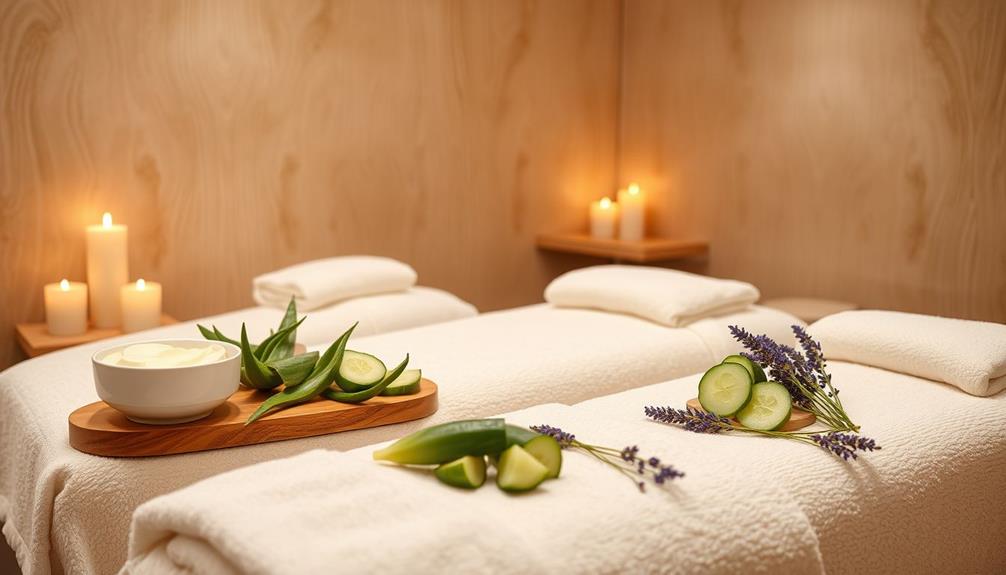
Creating a personalized spa experience means understanding the unique needs of different skin types.
For clients with dry skin, focus on hydrating treatments that incorporate ingredients like hyaluronic acid and aloe vera. Rich oils, such as jojoba or argan, can be added to facials for extra nourishment, ensuring their skin feels revitalized.
When catering to those with oily skin, oily skin treatments should involve clay masks containing kaolin or bentonite to absorb excess oil and unclog pores. Exfoliating scrubs with salicylic acid will help prevent breakouts and keep their skin clear.
For sensitive skin, formulate soothing masks with chamomile or calendula to calm any irritation. Always opt for fragrance-free, hypoallergenic products to minimize the risk of allergic reactions.
Combination skin requires a tailored approach. Create customized facials that balance both oily and dry areas, applying lightweight moisturizers on oilier zones and richer creams on drier patches.
Lastly, for mature skin treatments, incorporate anti-aging ingredients like retinol and peptides into your offerings. Pair these with facial massages to stimulate circulation and promote skin elasticity, ensuring your clients feel rejuvenated.
Enhancing the Experience With Music

To truly elevate your DIY spa experience, creating a curated playlist is key.
Choose soothing tracks that resonate with you, ideally with slow tempos around 60-80 beats per minute, to help your mind unwind.
You might also consider incorporating nature-inspired soundscapes, like flowing water or gentle winds, to enhance relaxation and transport you to a serene environment.
Curated Playlist Creation
While you unwind during your DIY spa treatments, a well-curated playlist can transform your experience into a serene retreat. Research shows that calming music can notably lower heart rates and reduce stress levels, enhancing your relaxation.
Start by incorporating a variety of genres such as classical, ambient, and nature sounds. This diverse auditory atmosphere caters to different preferences and keeps the experience fresh.
Aim for a playlist duration of at least 60 to 90 minutes. This guarantees a continuous background ambiance that aligns perfectly with your spa treatments or activities. Music streaming services offer pre-made wellness playlists, or you can blend tracks to create a personalized soundscape that complements your retreat center.
Don't forget to take into account instrumental tracks without lyrics. They minimize distractions and promote deeper mindfulness during meditation or self-care sessions, much like a personal chef crafting a meal tailored to your taste.
Soundscapes for Relaxation
Soundscapes play an essential role in enhancing your relaxation experience during DIY spa treatments. Incorporating soothing sounds can greatly reduce stress levels and promote a sense of wellness. Studies show that calming music can lower stress by up to 61%, making it a crucial element in your retreat setting.
Here's a quick reference table to help you choose the right soundscapes for relaxation:
| Sound Type | Benefits | Ideal Use Case |
|---|---|---|
| Nature Sounds | Lowers blood pressure, promotes calm | Ambient background during treatments |
| Binaural Beats | Facilitates deep relaxation | Guided meditations or yoga sessions |
| Soft Instrumentals | Induces a meditative state | Pre-treatment relaxation sessions |
Encouraging Mindfulness During Treatments

Incorporating mindfulness into your DIY spa treatments can transform your experience, making it not just a moment of pampering but a journey of self-discovery and relaxation. By integrating mindfulness practices, you can greatly enhance the overall wellness experience, as studies show they can reduce stress and anxiety by up to 30%.
Here are some effective ways to encourage mindfulness during treatments:
- Guided Breathing Exercises: Start with breathing exercises to help participants center themselves and focus on the present moment, enhancing their relaxation.
- Soothing Sounds: Play calming music or nature sounds to create a tranquil environment, which can lower heart rates and promote deeper relaxation.
- Body Scanning Techniques: Encourage participants to mentally check in with different body parts, fostering greater awareness and connection to their physical sensations.
Additionally, offering post-treatment reflection prompts or journaling opportunities can help individuals process their experiences, reinforcing mindfulness and leading to sustained emotional benefits beyond the retreat.
Frequently Asked Questions
How Do You Give Yourself a Spa Treatment at Home?
To give yourself a spa treatment at home, dim the lights, light candles, and play soothing music. Use high-quality skincare products, enjoy a warm bath, and incorporate aromatherapy to create a relaxing atmosphere.
How Do I Create a Spa-Like Experience at Home?
Think of a serene forest retreat; to create that spa-like experience at home, dim the lights, diffuse calming essential oils, play gentle music, and prepare soothing treatments, all while designating a peaceful relaxation space.
How to Plan a Wellness Retreat?
To plan a wellness retreat, start by defining your goals. Create a balanced schedule of activities, maintain a calming environment, serve nutritious meals, and include time for self-reflection to enhance participants' overall experience.
How Do I Turn My House Into a Spa Retreat?
To turn your house into a spa retreat, designate a relaxation area, declutter, and add cozy seating. Use calming scents, prepare healthy meals, and incorporate meditation to create a soothing atmosphere that rejuvenates your spirit.
Conclusion
By incorporating these DIY spa treatments into your retreat center, you're not just offering relaxation—you're releasing a tidal wave of rejuvenation that'll leave your guests feeling like they've just floated on clouds! Imagine the blissful sighs as they indulge in homemade scrubs and masks, all while soaking up a serene atmosphere. With each treatment, you're not just pampering them; you're transforming their lives into a heavenly escape they won't soon forget. So, let the pampering begin!
- About the Author
- Latest Posts
Introducing Ron, the home decor aficionado at ByRetreat, whose passion for creating beautiful and inviting spaces is at the heart of his work. With his deep knowledge of home decor and his innate sense of style, Ron brings a wealth of expertise and a keen eye for detail to the ByRetreat team.
Ron’s love for home decor goes beyond aesthetics; he understands that our surroundings play a significant role in our overall well-being and productivity. With this in mind, Ron is dedicated to transforming remote workspaces into havens of comfort, functionality, and beauty.
Retreat
The Role of Technology in Modern Retreat Centers
Amidst nature’s tranquility, technology revolutionizes retreat centers—discover how innovations enhance wellness experiences in ways you never imagined.

Technology plays an essential role in modern retreat centers by enhancing your experience and promoting wellness. You'll find interactive learning through AR and VR, replacing traditional seminars for a more engaging atmosphere. AI tailors programs to meet your unique preferences, while biofeedback devices support mindfulness practices. Plus, drones capture stunning moments and landscapes, encouraging reflection without intruding on nature. Many retreats now embrace eco-friendly practices, balancing tech with the tranquility of the outdoors. As you explore further, you'll discover how these innovations shape the future of wellness and retreat experiences.
Key Takeaways
- Modern retreats utilize AR and VR to create immersive learning experiences that enhance participant engagement and understanding.
- AI technologies analyze guest preferences to personalize wellness programs and improve overall satisfaction during retreats.
- Digital tools streamline communication and program management, allowing facilitators to focus on enhancing guest experiences.
- Biofeedback devices support mindfulness practices, helping participants achieve deeper relaxation and stress reduction during their stay.
- Retreats incorporate tech-free zones to foster genuine interactions, balancing technological benefits with the need for connection to nature.
Impact of Technology on Retreats

As technology continues to evolve, retreat centers are embracing innovative tools to enhance your experience. You'll find that modern retreats are shifting from a traditional focus on disconnection to a more tech-savvy approach that promotes rejuvenation and meaningful connections.
With the integration of Augmented Reality (AR) and Virtual Reality (VR), these centers create immersive learning and team-building activities that captivate your attention. Additionally, AI-Powered Virtual Reality in E-Learning is revolutionizing group dynamics and personal growth during these retreats. Digital platforms play a crucial role in replacing monotonous seminars with interactive learning experiences, encouraging participation and collaboration among attendees.
You'll engage more deeply, fostering a sense of community and shared purpose. Furthermore, technology helps preserve your retreat moments through drones and digital photography, allowing you to document activities and landscapes in a way that enhances storytelling through multimedia presentations.
In wellness activities, tools like biofeedback devices support mindfulness and stress reduction, helping you achieve ideal relaxation levels. By integrating these advanced technologies, retreat centers aren't just keeping pace with the times; they're enhancing your overall retreat experience, making it more engaging, memorable, and transformative.
Embracing technology in this way guarantees your time spent at a retreat center is both invigorating and enriching.
Enhancing Guest Experiences

Modern retreat centers are revolutionizing guest experiences by leveraging data-driven technologies to tailor offerings that align with your individual preferences. This approach not only enhances satisfaction but also cultivates loyalty, ensuring that your stay is memorable and fulfilling.
With the rise of wellness tourism projected to exceed $1 trillion in 2024, retreat centers are expanding their holistic wellness offerings. These tailored experiences are crafted using AI tools, which help in understanding your unique needs for relaxation and productivity.
For instance, centers might offer specialized juice diets, considering that juice diets may lead to nutrient deficiencies if not balanced.
Here's what you can expect:
- Personalized wellness programs that adapt to your health goals
- Customized dining options reflecting local culture and your dietary preferences
- Engaging activities designed specifically for your interests
- Seamless integration of ancillary services for a smooth experience
Integration of Digital Tools

In today's retreat centers, integrating digital tools transforms how you engage with wellness activities and connect with others. Platforms like Venue360 streamline communication between facilitators and participants, enhancing your overall experience through efficient program management. This approach allows for improved budget management as participants can track their spending on retreat activities and resources.
You can easily access schedules, resources, and even feedback, making your retreat more organized and enjoyable.
Moreover, augmented reality (AR) and virtual reality (VR) are increasingly used to create interactive learning experiences, allowing you to foster collaboration and participation among fellow attendees. This integration of digital tools not only makes sessions more engaging but also deepens your understanding of wellness concepts.
Biofeedback devices guide you in meditation practices, helping improve your relaxation and mindfulness. These tools provide real-time data, allowing you to see your progress and adjust your techniques. Additionally, drones and digital photography capture memorable moments, encouraging reflection and sharing with others.
While embracing these advancements, retreat centers focus on balancing digital and analog elements. This guarantees that technology enhances, rather than detracts from, your goals of introspection and genuine connection with others during your retreat experience.
Balancing Tech and Nature
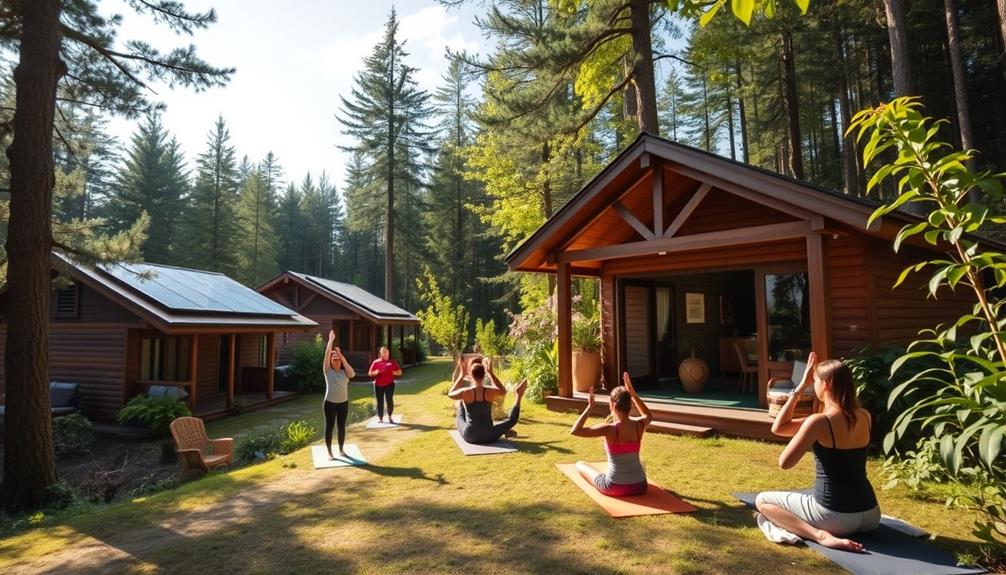
Integrating technology into retreat centers enhances your experience, but it's important to maintain a strong connection with nature. Balancing tech and nature is essential for a fulfilling retreat, guaranteeing that while you enjoy the benefits of digital tools, you also immerse yourself in the natural world around you.
To achieve this balance, consider these key aspects:
- Mindful use of technology: Use tools like AR and VR for immersive learning, but limit distractions that pull you away from the environment. Incorporating elements like essential oil benefits can enhance your sensory experience and promote relaxation.
- Capture moments without intruding: Employ drones and digital photography to document the beauty of nature and your experiences, fostering deeper connections.
- Facilitate wellness practices: Integrate technology like biofeedback to enhance meditation, but guarantee it complements rather than overwhelms your introspective time.
- Create tech-free zones: Establish areas in the retreat center where devices aren't permitted, encouraging genuine interactions and a fuller experience of the surroundings.
Future Trends in Retreat Centers

As retreat centers evolve, they're embracing innovative trends that cater to the growing demand for personalized wellness experiences. With the wellness tourism market projected to exceed $1 trillion in 2024, you can expect retreat centers to expand their offerings to include holistic wellness experiences tailored to your individual needs.
Advances in AI and data-driven technology enable these centers to personalize your experience, enhancing satisfaction and loyalty through tailored offerings based on your preferences. This approach mirrors the principles of design thinking, which emphasizes empathy and user-centric solutions in creating impactful experiences.
The integration of augmented and virtual reality into retreat programs is transforming traditional learning into immersive and interactive formats. This fosters collaboration and engagement among participants, making your experience more enriching.
Additionally, the rise of "bleisure" travel means retreat centers are accommodating remote work needs with tailored productivity solutions and flexible spaces for professionals like you who blend business and leisure.
Sustainability is also taking center stage, with many retreat centers adopting green transportation options and eco-friendly practices. This aligns with corporate environmental responsibility goals while enhancing your overall experience.
As these trends unfold, expect a more customized, engaging, and responsible retreat experience that truly caters to your unique wellness journey.
Frequently Asked Questions
What Is the Role of Technology in Peace Building?
Technology plays an essential role in peacebuilding by enhancing communication, fostering collaboration, and providing immersive experiences. You can use digital platforms and data-driven tools to connect, learn, and develop conflict resolution skills effectively.
What Is the Central Role of Technology in Modern Society?
Like a bridge, technology connects you to the world, facilitating instant communication and collaboration. It personalizes experiences, enhances productivity, and transforms how you interact, shaping modern society into an interconnected web of relationships and opportunities.
What Is a Tech Retreat?
A tech retreat combines digital tools with relaxation, fostering meaningful connections. You'll engage in immersive experiences using AR and VR, while also participating in interactive learning and mindfulness practices, all designed to enhance your overall experience.
Conclusion
In the tapestry of modern retreat centers, technology weaves vibrant threads that enhance your experience, making every moment more memorable. By integrating digital tools while respecting the serenity of nature, you find a harmonious balance. As trends evolve, these centers will continue to embrace innovation, ensuring that your retreat feels both invigorating and connected. So, whether you're seeking solace or inspiration, technology is here to enrich your journey without overshadowing the natural beauty that surrounds you.
- About the Author
- Latest Posts
Introducing Ron, the home decor aficionado at ByRetreat, whose passion for creating beautiful and inviting spaces is at the heart of his work. With his deep knowledge of home decor and his innate sense of style, Ron brings a wealth of expertise and a keen eye for detail to the ByRetreat team.
Ron’s love for home decor goes beyond aesthetics; he understands that our surroundings play a significant role in our overall well-being and productivity. With this in mind, Ron is dedicated to transforming remote workspaces into havens of comfort, functionality, and beauty.
-

 Retreat3 weeks ago
Retreat3 weeks agoDIY Aromatherapy Diffusers for a Spa-Like Atmosphere at Home
-

 Retreat4 weeks ago
Retreat4 weeks agoThe Profitability of Retreat Centers: A Financial Analysis
-

 Retreat2 weeks ago
Retreat2 weeks agoThe Business of Retreats: Marketing Strategies for Success
-
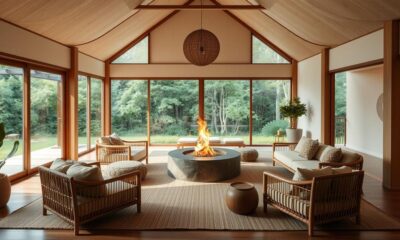
 Retreat2 weeks ago
Retreat2 weeks ago10 Unique Themed Room Ideas for Your Retreat Center
-

 Southeast Asia Decor2 weeks ago
Southeast Asia Decor2 weeks agoIndonesian Textiles Shaping Contemporary Interior Design
-

 Retreat3 weeks ago
Retreat3 weeks agoThe Psychology of Color in Retreat Center Design
-

 Retreat4 weeks ago
Retreat4 weeks agoUnusual DIY Projects: Designing a Space Probe in Bitlife
-

 Retreat3 weeks ago
Retreat3 weeks agoHow to Create a Zen Garden for Your Retreat Center











